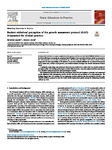Student midwives’ perception of the growth assessment protocol (GAP): Preparation for clinical practice
| dc.contributor.author | Lawes, Rebecca | |
| dc.contributor.author | Jones, Sharon | |
| dc.date.accessioned | 2021-11-09T14:41:03Z | |
| dc.date.issued | 2020-03 | |
| dc.identifier.issn | 1471-5953 | |
| dc.identifier.issn | 1873-5223 | |
| dc.identifier.other | 102756 | |
| dc.identifier.uri | http://hdl.handle.net/10026.1/18268 | |
| dc.description.abstract |
Fetal growth restriction is a major complication of pregnancy and increases the risk of stillbirth. Midwives screen for fetal wellbeing by measuring the symphysis fundal height to detect growth restriction, which can present in a low risk pregnancy or occur late in gestational age. The detection, surveillance and onward referral of these pregnancies are the responsibility of all midwives. To prevent avoidable stillbirth due to restricted fetal growth and to ensure safe, evidence based practice, the Perinatal Institute developed the Growth Assessment Protocol (GAP). A qualitative study using semi-structured interviews was conducted to explore 2nd year student midwives' perception of the GAP training and its impact on their clinical practice. Data was analysed and four main themes were identified using interpretative phenomenological analysis. The findings from the study show that the participants viewed the GAP training as 'authentic' and commented on the alignment with contemporary practice for the detection and surveillance of at risk pregnancies. The findings suggest that GAP training for pre-registration student midwives has the potential to provide a sustainable workforce, prepared to meet the World Health Organisation's global strategy for eliminating avoidable stillbirth by 2030. | |
| dc.format.extent | 102756-102756 | |
| dc.format.medium | Print-Electronic | |
| dc.language | en | |
| dc.language.iso | en | |
| dc.publisher | Elsevier | |
| dc.subject | Growth assessment protocol | |
| dc.subject | Midwifery education | |
| dc.subject | Avoidable stillbirth | |
| dc.subject | Fetal growth restriction | |
| dc.title | Student midwives’ perception of the growth assessment protocol (GAP): Preparation for clinical practice | |
| dc.type | journal-article | |
| dc.type | Journal Article | |
| plymouth.author-url | https://www.webofscience.com/api/gateway?GWVersion=2&SrcApp=PARTNER_APP&SrcAuth=LinksAMR&KeyUT=WOS:000528261100026&DestLinkType=FullRecord&DestApp=ALL_WOS&UsrCustomerID=11bb513d99f797142bcfeffcc58ea008 | |
| plymouth.volume | 44 | |
| plymouth.publication-status | Published | |
| plymouth.journal | Nurse Education in Practice | |
| dc.identifier.doi | 10.1016/j.nepr.2020.102756 | |
| plymouth.organisational-group | /Plymouth | |
| plymouth.organisational-group | /Plymouth/Faculty of Health | |
| plymouth.organisational-group | /Plymouth/Faculty of Health/School of Nursing and Midwifery | |
| plymouth.organisational-group | /Plymouth/Research Groups | |
| plymouth.organisational-group | /Plymouth/Research Groups/Institute of Health and Community | |
| plymouth.organisational-group | /Plymouth/Users by role | |
| plymouth.organisational-group | /Plymouth/Users by role/Academics | |
| dc.publisher.place | Scotland | |
| dcterms.dateAccepted | 2020-02-28 | |
| dc.rights.embargodate | 2021-11-13 | |
| dc.identifier.eissn | 1873-5223 | |
| dc.rights.embargoperiod | Not known | |
| rioxxterms.versionofrecord | 10.1016/j.nepr.2020.102756 | |
| rioxxterms.licenseref.uri | http://www.rioxx.net/licenses/all-rights-reserved | |
| rioxxterms.licenseref.startdate | 2020-03 | |
| rioxxterms.type | Journal Article/Review |


